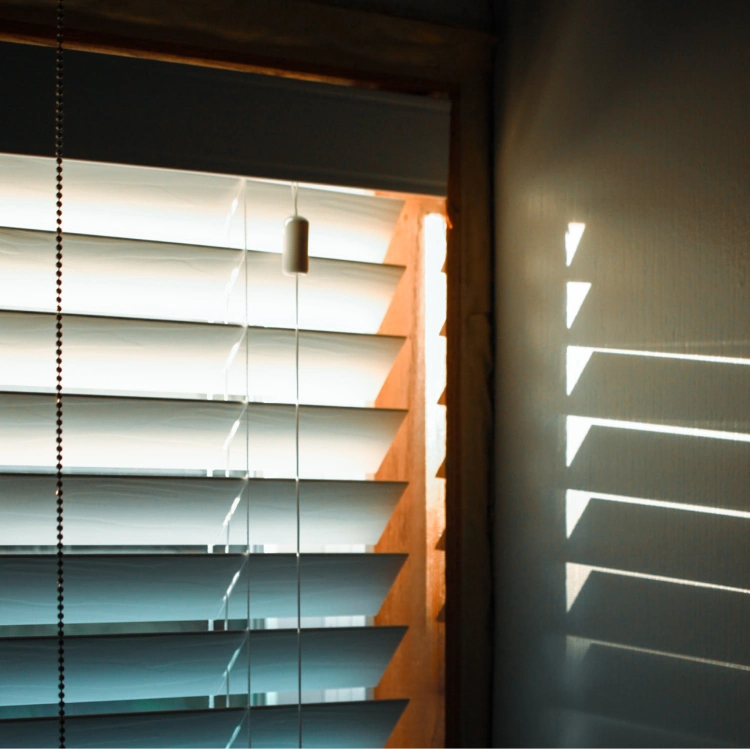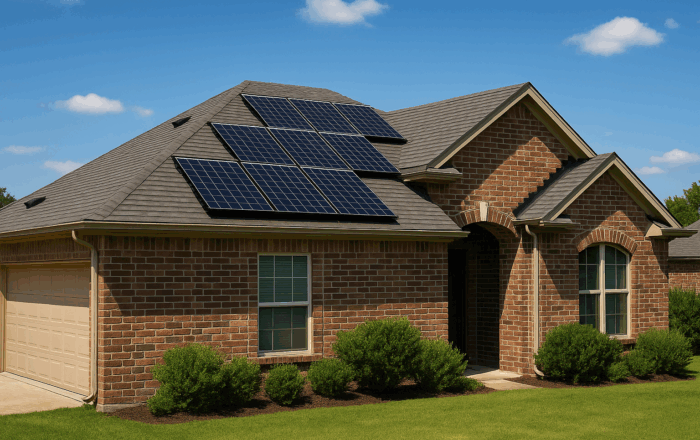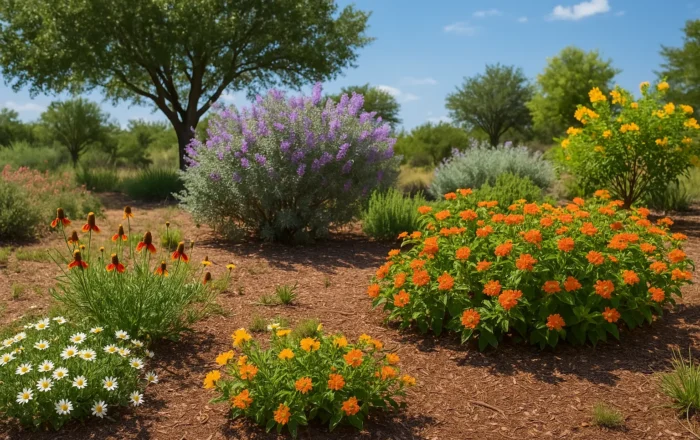Home Improvement Living in Texas
How Many Solar Panels Do You Need in Texas?
4 minute readHow to calculate the number of solar panels you need to power your Texas home
Home > BKV Energy Blog > All Posts > What Temperature to Set Your Thermostat in Summer
7 minute read • Last update July 2025

According to the U.S. Department of Energy, 78 degrees Fahrenheit is the best summer thermostat temperature setting for when you’re at home. This is the best temperature setting to achieve a balance between comfort, energy savings, cost efficiency, and environmental sustainability.
When you’re not at home during the summer, set your thermostat to 80 degrees Fahrenheit or higher. It takes less energy to cool your home back down when you get in than it does to leave AC units running at a consistently lower temperature while you’re out for several hours. It’s estimated that turning your thermostat up by 7-10 degrees Fahrenheit (2-3 degrees Celsius) while you’re not home can reduce energy costs by up to 10%.
When summer arrives and temperatures rise, most of us rely heavily on our air conditioning systems. However, many people overlook the significance of maintaining the correct AC setting in summer, resulting in suboptimal cooling performance, increased energy consumption, and unnecessarily high utility bills.
In this guide, we’ll explore the importance of monitoring your AC settings during the summer months and provide a list of top tips to help you find new ways to maximize comfort and save money on utilities.

The primary purpose of any heating, ventilation, and air conditioning (HVAC) system is to create a comfortable indoor living environment. Selecting a suitable AC setting in summer provides a welcome respite from the sweltering heat, allowing you and your family to enjoy a cool and refreshing atmosphere. But there are several other important factors to consider too, including:
You’ll need to experiment a little to find the best temperature settings that balance both comfort and affordability. Remember that even a small increase in temperature can lead to significant energy savings, so finding the sweet spot where you feel comfortable without excessive cooling is essential. Taking proactive steps to avoid the following common mistakes will ensure you don’t unknowingly compromise the cooling efficiency of your home and incur unnecessary expenses.
While arctic-like cooling may feel like the best approach – especially when you first come in from the summer heat on a sweltering day – it often makes leaving again even harder, meaning you’ll struggle to adjust whenever you step outside. Plus, as we’ve already mentioned, the strain on your AC system will significantly increase your energy consumption and utility bills.

An effective HVAC system should dehumidify the air as well as cool it. Neglecting to address high humidity levels results in an uncomfortable, sticky feeling, leading to potential moisture-related issues like mold and mildew growth.
Routine maintenance, like cleaning or replacing air filters and checking refrigerant levels, is essential for optimal performance and energy efficiency. Failure to adequately maintain your AC system can lead to reduced cooling capacity, increased energy consumption, and frequent breakdowns that result in costly repairs.
To ensure the best AC setting in summer, you’ll need to consider the following factors and make thermostat adjustments accordingly to enhance cooling and improve overall efficiency.
Older units often struggle to cool your home efficiently, requiring longer operating times and lower temperature settings to achieve the desired comfort level.
Hot and humid climates typically require lower temperature settings. Conversely, milder climates usually allow for higher thermostat settings without sacrificing comfort.
Insufficient insulation can result in air leaks, allowing cool air to escape and warm air to enter. The increased demand on your AC system often necessitates lower thermostat settings to compensate.
The more direct sunlight your home receives, the more it will heat up through the day and the harder your AC system will have to work to maintain a cool and comfortable inside temperature.
It’s normal for household members to experience temperature differently. So finding a thermostat setting that meets everyone’s needs while being mindful of energy consumption and cost savings can take some trial and error.
Larger rooms typically require longer cooling cycles and/or lower temperature settings to ensure comfort, whereas smaller spaces are more economical to cool and keep cool.
Experts agree that investing in a smart or programmable thermostat is the best way to optimize energy efficiency because you can set specific temperature schedules to control your indoor environment based on your daily routine. Setting your thermostat to the highest comfortable temperature is good practice because a raise of just a few degrees can significantly reduce your electricity consumption. Advances in technology have revolutionized how we cool and heat our homes. Investing in a programmable thermostat allows you to set automatic heating schedules. Smart thermostat systems go even further by offering even more intuitive solutions.
Smart and programmable thermostats provide a range of benefits that save energy and enhance overall comfort and convenience by allowing you to set temperature schedules that align with your household’s daily routine. By automating adjustments when you’re out of the house, you can conserve energy by eliminating unnecessary cooling. Advanced models even have algorithms that learn your preferences and make automatic adjustments to optimize energy efficiency.
The exact model you choose will depend on the specific requirements of your home and household. However, here are some of the most popular brands you may wish to research:
As the summer heat intensifies, implementing effective strategies to improve energy efficiency can make you considerably more comfortable – without having to stress about an obscene energy bill at the end of each month. Here are a few tips for ensuring a more enjoyable living space – even on the hottest summer days.
Ensure proper airflow by keeping vents unobstructed and using ceiling fans to help circulate cool air. Be sure to position ceiling fans strategically to create cross-ventilation, and take advantage of cooler mornings and evenings by opening windows and allowing fresh air to circulate. Zoning systems that set different temperatures for individual rooms can also be beneficial in optimizing comfort and energy efficiency.

This is a simple yet effective way to block out sunlight and prevent heat gain. Window coverings like blinds and curtains block direct sunlight during the hottest parts of the day while still allowing airflow. For the best results, opt for light-colored or reflective window coverings that reflect sunlight away from your windows and reduce the workload on your AC units.
Upgrading your insulation – particularly in the attic, walls, and floors – is a great way to improve energy efficiency and prevent your AC system from having to work too hard. Additionally, using weather stripping or caulk to seal gaps and cracks around doors, windows, and vents will enhance HVAC efficiency and reduce energy waste.
Using AC in the evening requires a slightly different approach to daytime operation. Once the sun sets, there’s usually a noticeable difference as the ambient temperature drops. So savvy homeowners can optimize their AC settings to minimize energy consumption while still ensuring comfort.
When the outdoor temperature drops, you don’t need to ramp down the AC temperature as much to feel cool. By increasing the thermostat by a few degrees in the evening, you can avoid energy usage spikes that result from excessive cooling. Research shows that for every degree you raise the temperature, you can save up to 3% on your cooling costs. So, if you consistently adjust your thermostat at night time during the summer months, you stand to make considerable savings.
Most modern air conditioners come equipped with a sleep mode. Also known as night mode, the sleep function is designed to gradually adjust the temperature setting and fan speed to match your comfort needs while you rest. Activating sleep mode before bedtime ensures a comfortable night’s slumber without overcooling your home or wasting energy.
As you can see, managing your AC setting in summer is crucial for both comfort and energy-efficiency purposes. By implementing the right strategies, homeowners can create a cool and pleasant indoor environment while minimizing energy consumption and utility costs.
One of the best ways to ensure optimum AC efficiency and minimize energy bills is to choose a reliable energy supplier with a range of simple and straightforward plans. At BKVE, we specialize in providing our customers with cleaner, greener, and more cost-effective energy solutions, and we’re always working to produce power when it’s needed most.
Let’s recap the primary considerations with a list of things you should consider when setting your thermostat during the summer months:
Tips for saving extra energy include closing blinds and curtains, upgrading insulation, sealing leaks to prevent heat gain, raising the temperature in the evening, and utilizing sleep mode when you go to bed.
Graham Lumley, Digital Marketing Manager at BKV Energy, leads digital and traditional marketing strategies, focusing on educating Texans about the state's deregulated energy market. With over 8 years of marketing experience, he creates content to help consumers understand and save on their energy bills, bringing a fresh and dynamic approach to the industry.

Home Improvement Living in Texas
How to calculate the number of solar panels you need to power your Texas home

Gardening in Texas presents unique challenges. Long, hot summers and frequent droughts mean that traditional landscaping often requires significant water
Get $50 off your electric bill!
Use code BKVEJOINUS50
Enter your zip code to shop BKV Energy's affordable, fixed-rate Texas electricity plans. Use the promo code for $50 off your electric bill.